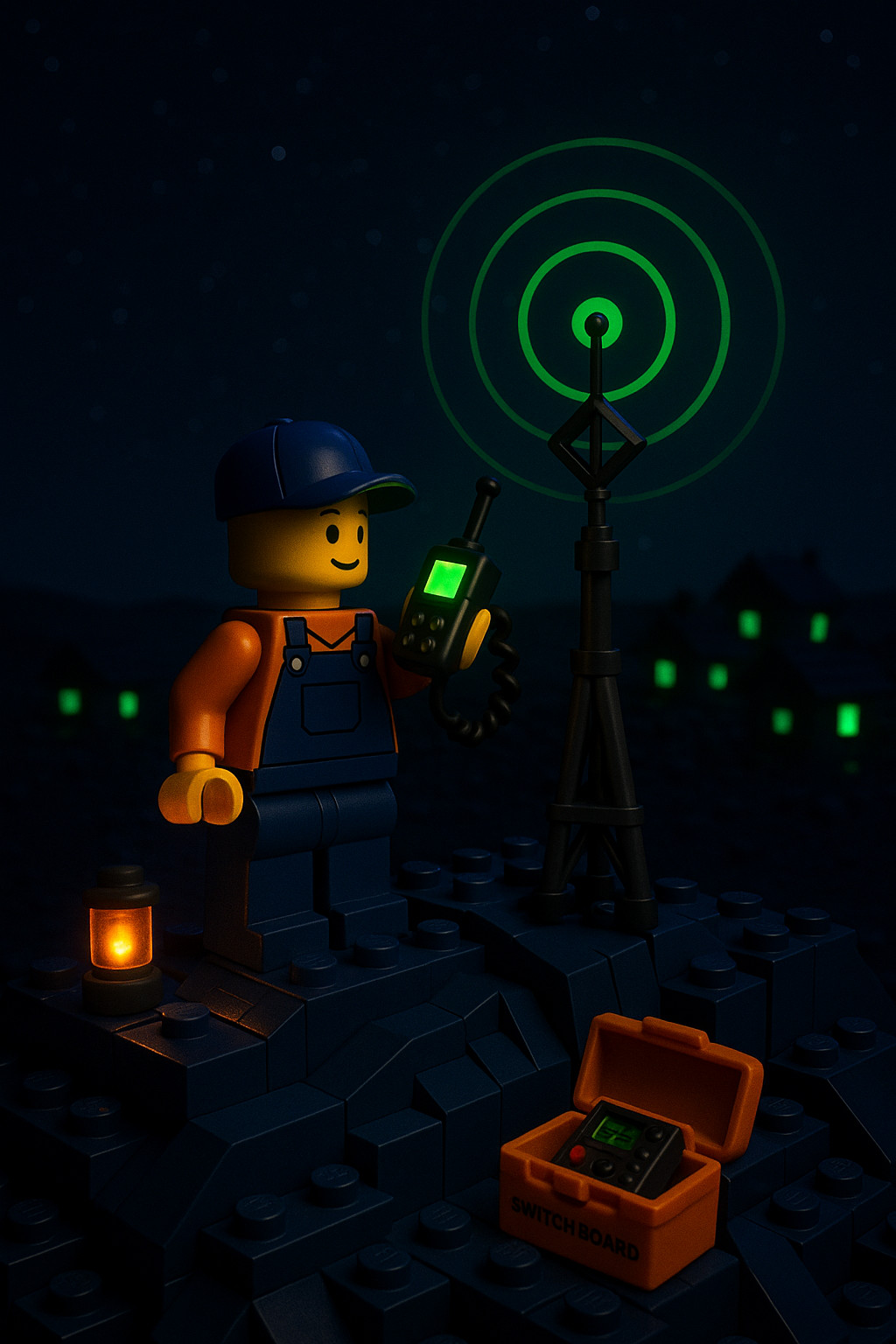How to Communicate Without the Internet: LoRa, Mesh, and Magic

Table of Contents
How to Communicate Without the Internet: LoRa, Mesh, and Magic#
By Switchboard Tech Services – Kirksville, Missouri
The Illusion of Always-On#
The Internet feels eternal until your router blinks out, your cell tower goes dark, and your favorite cloud app suddenly becomes a paperweight.
It is, in truth, a house of cards – one cut cable, one storm, or one power failure away from silence.
We rely on a fragile web of cables, satellites, and server farms to do the simplest thing humans have done for centuries: talk.
When that breaks, we realize how little we actually own of our own communication.
That is where the magic comes back – literal radio waves, bouncing quietly across the air, ready to carry our words again.
Note: This article stems from easy systems (Meshtastic) to advanced, more hobbyist systems (ESP32 kits).
When the Net Blinks Out#
Ask anyone in a rural area. The “always-on” Internet is mostly “usually-off.”
A single downed line or lightning strike can knock out communication for miles.
No messages, no maps, no updates. Even smart locks and thermostats start to act dumb.
And yet – this is the most predictable kind of outage imaginable.
Power grids fail. Networks get congested.
The fallback layer – the local, neighbor-to-neighbor layer – is what we’ve lost in the name of convenience.
But it is surprisingly easy to rebuild.
Ancient Magic: Radio Waves Never Went Away#
Before there was Wi-Fi, there was radio. It never went anywhere – we just stopped paying attention.
The air around you is filled with signals, many of which are free to use under ISM bands
(Industrial, Scientific, and Medical).
These include frequencies like 433 MHz, 868 MHz, and 915 MHz – open bands where small devices can whisper data to one another for miles.
That whispering part is where LoRa comes in.
LoRa: The Whisper Network#
LoRa (short for “Long Range”) is a wireless technology that lets tiny radios send data over astonishing distances while sipping almost no power.
It is not fast – think of it as the telegraph, not broadband – but it is incredibly steady.
- One node on a hill can reach another several miles away.
- Each node can be battery or solar powered.
- They can talk without Wi-Fi, cell towers, or Internet service.
The hardware is small and inexpensive. You can find open-source LoRa boards such as:
LilyGO TTGO LoRa32 or Heltec WiFi LoRa 32.
Pair them with a little open firmware, and you have the beginnings of a neighborhood network.
Projects like Meshtastic have made this even easier –
a friendly, open-source system that lets people send messages across a radio mesh, phone-free.
Mesh Networks: The Neighborhood Internet#
A mesh network is a collection of nodes that all relay for one another.
No single hub. No central control. Just cooperation.
Each node extends the network for everyone else.
If one goes down, the rest route around it automatically.
That’s what makes it the antidote to the “house of cards” problem – there’s no one card that can topple the whole thing.
LoRa-based mesh systems are already being used by hikers, rural communities,
and off-grid tinkerers around the world. They can run quietly for weeks on a single charge.
It’s not about isolation; it’s about independence.
Building a Fallback Layer#
The clever part is combining these pieces.
Imagine a few LoRa nodes around town – each running Meshtastic or a similar firmware –
connected by solar panels or backup batteries.
Add a small gateway (like a Raspberry Pi or ESP32 with Wi-Fi) and you can bridge messages
between the mesh and the Internet when it is available,
but keep it running even when it’s not.
That is a fallback layer: an independent, local communication web that does not beg permission from the cloud.
Communication as a Commons#
This is the philosophical heart of it: communication should belong to everyone.
When only a few corporations control the pipes, outages become monopolies of silence.
LoRa and mesh networks put the means of connection back in our own hands.
They are the radio equivalent of the right-to-repair movement –
a way of saying, “We can fix this ourselves.”
And yes, it feels a little like magic. Because it is.
Real-World Use Cases#
- Farms can share sensor data across fields with no cellular plan.
- Neighborhoods can pass messages during storms or power outages.
- Hobbyists can build private text networks for fun or privacy.
- Rural towns (like ours here in Kirksville) can stay in touch when the big pipes go down.
This is practical technology, not paranoia – it’s a safety net that also happens to be fascinating to build.
Getting Started#
https://meshtastic.org/ « to get a quick start with ready-made hardware.
OR
- Pick up a LoRa board (like LilyGO TTGO).
- Flash it with Meshtastic firmware.
- Power it on and connect via Bluetooth to the phone app.
- Start chatting – locally, privately, and completely off-grid.
The FCC allows these unlicensed bands for personal and experimental use,
as long as you follow the power limits and avoid interference.
(Translation: do not turn your homebrew antenna into a backyard radar cannon.)
The Magic, Reclaimed#
The Internet is wonderful – until it is not.
When it fails, it takes with it our sense of connection and control.
But LoRa, mesh, and a bit of open-source ingenuity remind us that communication
does not have to depend on someone else’s server.
The air around us is still free.
All we need are the right tools – and the will to use them.
Switchboard Tech Services – Building resilient, local technology in Kirksville, Missouri.
https://switchboardtechservices.com